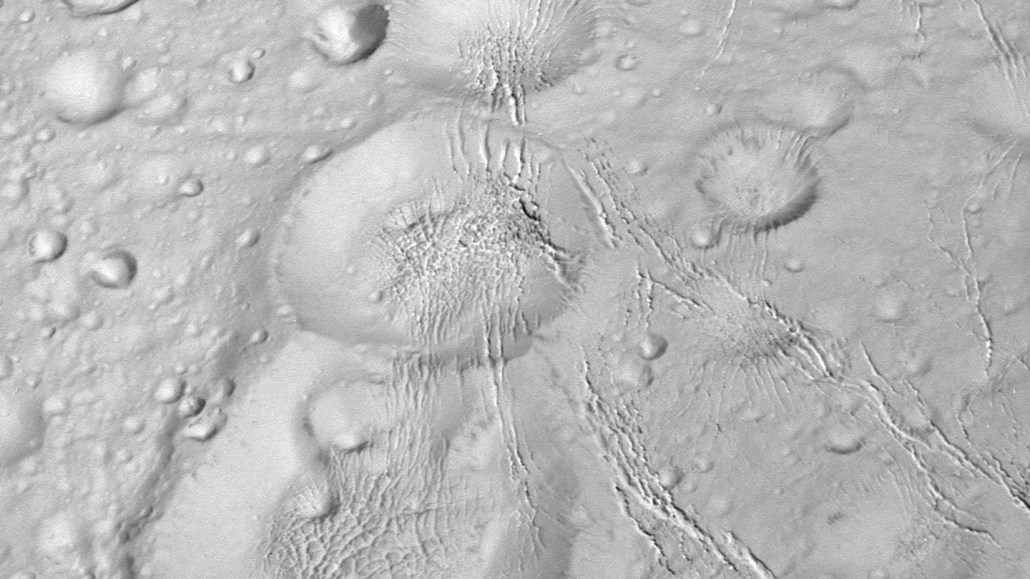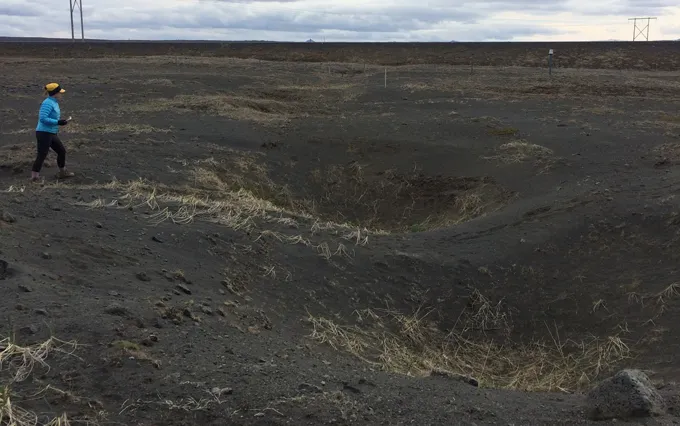Enceladus is blanketed in a thick layer of snow
The fluff suggests the moon’s famous plume was once more active than it is today

This chain of craters on Enceladus looks like a Saturnian snowman, but it’s actually made from snow draining into fissures underneath.
JPL-Caltech/NASA, Space Science Institute
- More than 2 years ago
Read another version of this article at Science News Explores
Saturn’s moon Enceladus is shrouded in a thick layer of snow. In some places, the downy stuff is 700 meters deep, new research suggests.
“It’s like Buffalo, but worse,” says planetary scientist Emily Martin, referring to the famously snowy city in New York. The snow depth suggests that Enceladus’ dramatic plume may have been more active in the past, Martin and colleagues report in the Mar. 1 Icarus.
Planetary scientists have been fascinated by Enceladus’ geysers, made up of water vapor and other ingredients, since the Cassini spacecraft spotted them in 2005 (SN: 12/16/22). The spray probably comes from a salty ocean beneath an icy shell.
Some of that water goes to form one of Saturn’s rings (SN: 5/2/06). But most of it falls back onto the moon’s surface as snow, Martin says. Understanding the properties of that snow — its thickness and how dense and compact it is — could help reveal Enceladus’ history, and lay groundwork for future missions to this moon.
“If you’re going to land a robot there, you need to understand what it’s going to be landing into,” says Martin, of the National Air and Space Museum in Washington, D.C.
To figure out how thick Enceladus’ snow is, Martin and colleagues looked to Earth — specifically, Iceland. The island country hosts geological features called pit chains, which are lines of pockmarks in the ground formed when loose rubble such as rocks, ice or snow drains into a crack underneath (SN: 10/23/18). Similar features show up all over the solar system, including Enceladus.

Previous work suggested a way to use geometry and the angle at which sunlight hits the surface to measure the depth of the pits. That measurement can then reveal the depth of the material the pits sit in. A few weeks of fieldwork in Iceland in 2017 and 2018 convinced Martin and her colleagues that the same technique would work on Enceladus.
Using images from Cassini, Martin and colleagues found that the snow’s thickness varies across Enceladus’ surface. It is hundreds of meters deep in most places and 700 meters deep at its thickest.
It’s hard to imagine how all that snow got there, though, Martin says. If the plume’s spray was always what it is today, it would take 4.5 billion years — the entire age of the solar system — to deposit that much snow on the surface. Even then, the snow would have to be especially fluffy.
It seems unlikely that the plume switched on the moment the moon formed and never changed, Martin says. And even if it did, later layers of snow would have compressed the earlier ones, compacting the whole layer and making it much less deep than it is today.
“It makes me think we don’t have 4.5 billion years to do this,” Martin says. Instead, the plume might have been much more active in the past. “We need to do it in a much shorter timeframe. You need to crank up the volume on the plume.”
The technique was clever, says planetary scientist Shannon MacKenzie of the Johns Hopkins University Applied Physics Laboratory in Laurel, Md. Without rovers or astronauts on the ground, there’s no way to scoop up the snow and see how far down it goes. “Instead, the authors are very cleverly using geology to be their rovers, to be their shovels.”
MacKenzie was not involved in the new work, but she led a mission concept study for an orbiter and lander that could one day visit Enceladus. One of the major questions in that study was where a lander could safely touch down. “Key to those discussions was, what do we expect the surface to be?” she says. The new paper could help “identify the places that are too fluffy to land in.”







